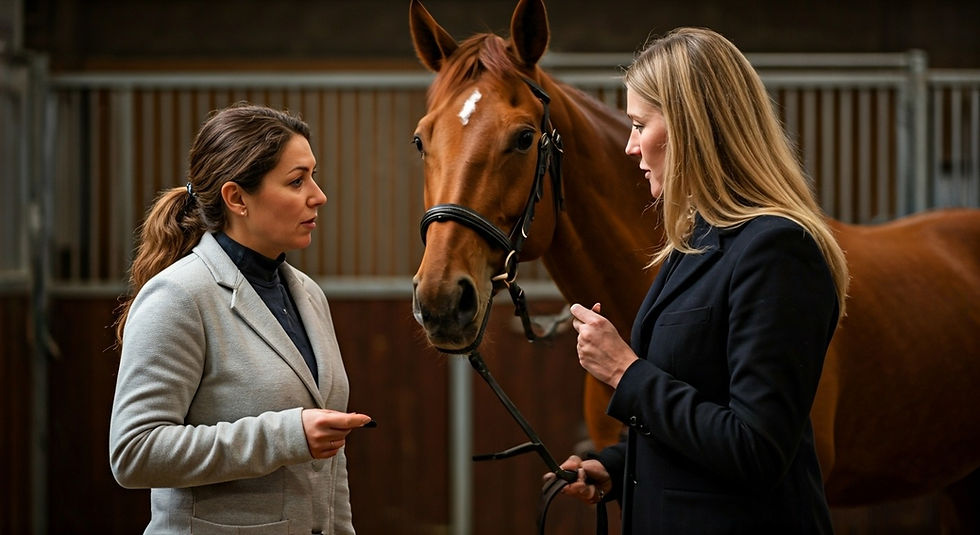How to Assess Problems in CBT for Sports: A Practical Guide
- Dr Paul McCarthy

- Aug 9
- 6 min read
Introduction
Cognitive Behavioral Therapy (CBT) has become a cornerstone intervention in sports psychology, helping athletes manage performance anxiety, enhance focus, and address mental health concerns. However, despite its widespread adoption, CBT in sports faces unique challenges that can limit its effectiveness. Properly assessing these problems is crucial for practitioners seeking to optimize their interventions. Research shows that CBT in sports faces unique challenges related to athlete psychology and performance demands. This article provides a systematic approach to identifying, evaluating, and addressing the common problems encountered when implementing CBT in sports contexts.

Current Challenges in CBT in Sports Psychology Implementation
The field of CBT in sports psychology continues to evolve as practitioners identify and address implementation challenges. One of the most significant issues is the lack of comprehensive research specifically focused on athletes with diagnosed mental health conditions. Current research indicates inconsistent definitions of mental health issues in sports psychology, with prevalence rates varying dramatically (4-48%) depending on assessment methods used.
When evaluating CBT in sports psychology programs, consider both mental health outcomes and performance metrics. This dual focus creates unique challenges, as improvements in psychological well-being don’t always translate directly to enhanced athletic performance. Additionally, the integration of psychological interventions into rigorous physical training regimens presents logistical and practical barriers that must be systematically assessed.
Key challenges to evaluate include:
The disconnect between psychological improvement and performance outcomes
Limited support systems for psychological interventions in sports settings
Difficulty incorporating mental training into physical training schedules
Resistance from coaches or sports organizations unfamiliar with psychological approaches
Evaluating CBT for Performance Anxiety Effectiveness in Athletes
Athletes often seek CBT for performance anxiety, but practitioners must assess its effectiveness in competitive contexts. Performance anxiety represents one of the most common issues addressed through CBT in sports, yet its treatment presents unique challenges compared to clinical anxiety treatment.
One common limitation when implementing CBT for performance anxiety is the difficulty in replicating competition stress during therapy. The high-pressure, public nature of athletic performance creates anxiety triggers that are challenging to simulate in therapeutic settings. Additionally, the physical components of performance anxiety (increased heart rate, muscle tension) may require integrated approaches beyond standard CBT protocols.
When assessing CBT effectiveness for performance anxiety, consider:
Whether interventions address both cognitive and somatic anxiety components
If techniques can be applied during actual competition, not just practice
The athlete’s ability to implement CBT strategies under extreme pressure
How well interventions account for sport-specific anxiety triggers

Assessing Limitations in Sports Anxiety Therapy Approaches
Effective sports anxiety therapy requires ongoing assessment to ensure it addresses the unique pressures of athletic performance. When evaluating sports anxiety therapy programs, consider both subjective improvement and objective performance measures. This dual assessment approach helps identify gaps between perceived psychological benefit and actual performance enhancement.
Common limitations to assess in sports anxiety therapy include:
Generic approaches that fail to account for sport-specific demands
Insufficient attention to the physical manifestations of anxiety
Lack of integration with physical training and competition schedules
Inadequate consideration of team dynamics in team sports
To properly evaluate these limitations, implement regular assessment protocols that gather feedback from athletes, coaches, and performance data. This multi-faceted approach provides a more comprehensive understanding of intervention effectiveness.
Analyzing Effective CBT Examples in Athletic Contexts
Analyzing CBT examples from clinical settings reveals adaptation needs for sports contexts. While traditional CBT has proven effective for general anxiety and depression, its application in sports requires significant modification to address the unique psychological landscape of athletes.
Practitioners should collect and assess CBT examples that have proven effective specifically with athlete populations. This involves examining case studies, research literature, and developing a repository of sport-specific interventions. When evaluating CBT examples, consider:
Relevance to the specific sport and its psychological demands
Adaptability to both individual and team settings
Integration potential with physical training regimens
Evidence of effectiveness with similar athlete populations
Successful CBT examples often feature modifications such as:
Incorporation of visualization techniques specific to athletic movements
Integration with physical practice sessions
Adaptation of cognitive restructuring to address performance-specific thoughts
Modification of exposure techniques to simulate competition environments
Evaluating CBT Activities for Groups in Team Sports Settings
Team sports present unique opportunities for CBT activities for groups, but require careful assessment of group dynamics. The collective nature of team sports creates both challenges and opportunities for CBT implementation. When implementing CBT activities for groups of athletes, coaches should be involved in the assessment process to ensure alignment with team goals and culture.
Effective assessment of group CBT activities should examine:
How well activities balance individual needs with team cohesion
Whether activities address both performance and interpersonal dynamics
The practicality of implementation within team training schedules
Cultural appropriateness for the specific team environment
Group-based CBT activities that typically require careful assessment include:
Team-based cognitive restructuring exercises
Collective goal-setting and performance review sessions
Peer-support mechanisms for anxiety management
Group relaxation and focus training
Measuring Cognitive Behavioral Therapy Effectiveness in Athletes
Measuring cognitive behavioral therapy effectiveness in athletes requires both psychological and performance metrics. Traditional CBT assessment tools often focus exclusively on symptom reduction, which may be insufficient in sports contexts where performance enhancement is a primary goal.
A comprehensive assessment framework should include:
Standardized psychological measures (anxiety, depression, well-being)
Sport-specific psychological metrics (competitive anxiety, confidence, focus)
Performance data (both objective and subjective measures)
Feedback from coaches and team members
Long-term follow-up to assess sustainability of improvements
The challenge lies in connecting psychological improvements to performance outcomes. Athletes may show significant improvement on psychological measures while experiencing minimal performance enhancement, or vice versa. This disconnect requires careful analysis to determine whether interventions need modification.
Gaps in Mental Health Treatment for Athletes
Gaps in mental health treatment for athletes often stem from sport-specific barriers that must be systematically identified. The athletic environment creates unique challenges for mental health treatment, including:
Stigma surrounding mental health issues in sports cultures
Limited access to sport-specialized mental health professionals
Competing priorities between performance and well-being
Confidentiality concerns in team environments
Regular athlete mental health assessment should be integrated into training programs to identify these gaps early. Assessment should examine not only the presence of mental health symptoms but also the specific barriers athletes face in seeking and receiving appropriate treatment.
Understanding Gender Differences in Athlete Therapy Response
Research indicates significant gender differences in athlete therapy responses that must be considered when designing and evaluating CBT interventions. Studies have shown that female athletes often show greater improvements in specific psychological components compared to male athletes, suggesting the need for gender-sensitive approaches.
When assessing CBT effectiveness, consider:
Different presentation of symptoms across genders
Varying response rates to specific CBT techniques
Gender-specific barriers to engagement with therapy
Cultural and social factors influencing therapy acceptance
These differences highlight the need for tailored assessment protocols that account for gender variations rather than applying one-size-fits-all evaluation methods.
Addressing Cultural Considerations in Sports CBT
Practitioners must address cultural considerations in sports CBT to ensure relevance and effectiveness across diverse athlete populations. Cultural factors influence how athletes perceive mental health interventions, engage with therapeutic techniques, and implement strategies in competitive contexts.
Assessment of cultural appropriateness should examine:
How well interventions align with athletes’ cultural values and beliefs
Whether language and concepts are culturally relevant
If techniques account for cultural variations in emotional expression
The cultural competence of practitioners delivering interventions
Cultural adaptation may require significant modifications to standard CBT protocols, including changes to language, metaphors, examples, and even core techniques to ensure relevance and acceptability.
Creating a Comprehensive Assessment Framework
To systematically evaluate problems in CBT for sports, practitioners should develop a structured assessment framework that addresses all the dimensions discussed above. This framework should include:
Initial Assessment Phase
Comprehensive athlete psychological profile
Sport-specific demands analysis
Cultural and gender considerations
Team dynamics evaluation (for team sports)
Implementation Assessment Phase
Practical integration with training schedules
Technique adaptation evaluation
Coach and support staff engagement
Resource availability assessment
Outcome Assessment Phase
Psychological measure tracking
Performance metric monitoring
Athlete satisfaction evaluation
Long-term sustainability assessment
This structured approach ensures that all potential problem areas are systematically evaluated, allowing for targeted modifications to enhance CBT effectiveness in sports contexts.
Conclusion on How to Access Problems in CBT
Assessing problems in CBT for sports requires a multidimensional approach that considers the unique psychological landscape of athletes, sport-specific demands, implementation challenges, and outcome measurement complexities. By systematically evaluating these factors, practitioners can identify limitations and develop targeted adaptations to enhance effectiveness.
The field of CBT in sports continues to evolve, with ongoing research addressing many of the gaps identified in this article. Practitioners should stay current with emerging evidence and regularly reassess their approaches to ensure they’re providing the most effective interventions possible.
By implementing the assessment frameworks and strategies outlined in this guide, sports psychologists, coaches, and mental health professionals can optimize CBT interventions to better serve athlete populations, addressing both performance enhancement and mental health needs in an integrated, effective manner.








